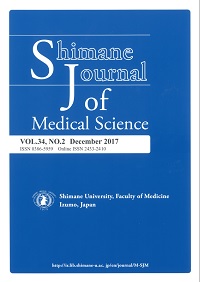Shimane University Faculty of Medicine
ISSN :0386-5959(in print)
ISSN :2433-2410(online)


These article are licensed under a Creative Commons Attribution-NonCommercial-NoDerivatives 4.0 International License.
number of downloads : ?
Use this link to cite this item : https://ir.lib.shimane-u.ac.jp/34511
Shimane Journal of Medical Science 3 2
1979-12-01 発行
Development of the Esophagus in Human Embryos -Special Reference to Histochemical Study on Carbohydrates
Tanaka, Osamu
Koh, Toshikiyo
Oki, Mitsuru
Description
Using 70 external normal human embryos at developmental stages ranging from 13 to 23 (5.1 to 29.3 mm in crown-rump length), that is, at five to eight weeks postconceptional age, the early development of the esophagus was examined by conventional and histochemical methods. Each material was sectioned serially, 35 embryos were stained with hematoxylin-eosin and in another 35 histochemical methods for determining carbohydrates, PAS, PARS, alcian blue, toluidine blue and colloid iron were used.
In the epithelium, small glycogen particles were seen distributed in the cytoplasm, and were dominant in the base at stage 13. With stage advancement, glycogen particles increased in number and size and were distributed equally in the cytoplasm. Glycoprotein was found on the free surface of the epithelium.In the mesenchyme, glycogen particles were distributed almost equally and showed no remarkable changes during the embryonic period. Acid mucopolysaccharides were equally distributed and were diffuse at stage 13. With stage advancement, these increased in volume, expect for the muscle layer, in which there was no increase.
Vacuoles were found from stages 19 to 22, but there was no occlusion of the lumen in these stages. Histochemically, there were no characteristic findings at these stages. The free glycogen particles found in the vacuoles, were considered to provide evidence of autolysis of the epithelium.
In the epithelium, small glycogen particles were seen distributed in the cytoplasm, and were dominant in the base at stage 13. With stage advancement, glycogen particles increased in number and size and were distributed equally in the cytoplasm. Glycoprotein was found on the free surface of the epithelium.In the mesenchyme, glycogen particles were distributed almost equally and showed no remarkable changes during the embryonic period. Acid mucopolysaccharides were equally distributed and were diffuse at stage 13. With stage advancement, these increased in volume, expect for the muscle layer, in which there was no increase.
Vacuoles were found from stages 19 to 22, but there was no occlusion of the lumen in these stages. Histochemically, there were no characteristic findings at these stages. The free glycogen particles found in the vacuoles, were considered to provide evidence of autolysis of the epithelium.
About This Article
Other Article
PP. 77 - 90
PP. 119 - 122
